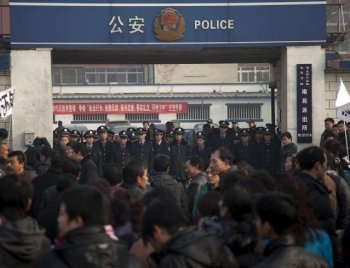WASHINGTON—After the fall of Hosni Mubarak in Egypt and Ben Ali in Tunisia, speculation has turned to China and prospects for a revolt to the Chinese Communist Party’s (CCP)’s rule of 61 years. No one can see into the future, but probably the majority of China scholars agree that the fissures between the people and their rulers have grown in the past decade. The Party will certainly be challenged to keep a lid on protests spinning out of control.
The U.S. -China Economic and Security Review Commission (USCC) held an on-the-record hearing with two panels, Feb. 25, regarding China’s “Internal Dilemmas.” Panel 1 gave testimony on the root causes of tens of thousands of protests every year and why the number keeps growing. This is the micro level of China’s popular unrest, which reveals that the Party will increasingly have its hands full in containing it. The details of this panel have been discussed in another Epoch Times report .
The Commission also heard from a second panel giving a macro perspective on the causes underlying mass protests and instability, namely, the major challenges to China’s economy and the likelihood that its high growth rate is not sustainable.
Despite heavy security, the total number of mass incidents by the end of 2008 had risen to 120,000, said Tanner. With the coming of economic downturn in 2009, it is quite possible the numbers climbed still higher in 2009 and 2010, according to Tanner.
Professor Xia Yeliang of Beijing University said in a Radio Free Asia interview that, according to the statistics from the CCP’s Political and Legal Committee, the number of group protests in 2009 rose to 230,000.
What is the nature of these protests? Dr. Elizabeth Economy, from the Council of Foreign Relations, listed land disputes, environmental issues and labor unrest. The Epoch Times and others have described eye-witness accounts of local officials expropriating land illegally and/or compensating well below market value.
Environmental protests may occur from “the failure of local officials and factory managers to enforce environmental regulations,” leading to riots, violence and deaths, testified Dr.Economy.
Labor issues are another growing source of unrest. Last year, workers achieved higher wages and better working conditions in the coastal area of China where there were labor shortages and better-educated workers. Strikes may be illegal in China but that didn’t deter the workers.
To Economy’s three major kinds of protests, Tanner would add withheld wages and pensions and “the refusal of local authorities to accept or honor citizen petitions.”
According to Tanner, it was not that there were more grievances that accounts for the steadily rising number of protests for two decades, but the absence of legal and political institutions that allow effective redress of grievances.
“Venting one’s frustrations in ways that are perceived to be taken seriously by the authorities are as important as actually resolving an issue,” said Yukon Huang, Carnegie Endowment for International Peace, on the second panel.
The first panel’s experts frequently mentioned the importance of the Internet and social media in the communication of social issues, for example, police beating protesters, and in helping to organize protests. As in Egypt and Tunisia, the Internet has become in China, “a virtual political system,” whereby a particular complaint or incident can be shown and in a matter of minutes “go viral,” said Dr. Economy.
Next: Recent calls for a ‘Jasmine Revolution’ in China began with a Twitter post
The U.S. -China Economic and Security Review Commission (USCC) held an on-the-record hearing with two panels, Feb. 25, regarding China’s “Internal Dilemmas.” Panel 1 gave testimony on the root causes of tens of thousands of protests every year and why the number keeps growing. This is the micro level of China’s popular unrest, which reveals that the Party will increasingly have its hands full in containing it. The details of this panel have been discussed in another Epoch Times report .
The Commission also heard from a second panel giving a macro perspective on the causes underlying mass protests and instability, namely, the major challenges to China’s economy and the likelihood that its high growth rate is not sustainable.
Micro Level Protests
The micro level view of social unrest indicates increasing protests over the past two decades. The latest data from the regime on the number of “mass incidents” is year 2008, when the regime prepared for the 2008 Olympics and afterward. Protests in Tibet were well publicized, but there were also, though less visible, significant incidents in Yunnan province: Weng’an, Guizhou, and Menglian, according to Dr. Murray Scot Tanner, an Asian security analyst at CNA.Despite heavy security, the total number of mass incidents by the end of 2008 had risen to 120,000, said Tanner. With the coming of economic downturn in 2009, it is quite possible the numbers climbed still higher in 2009 and 2010, according to Tanner.
Professor Xia Yeliang of Beijing University said in a Radio Free Asia interview that, according to the statistics from the CCP’s Political and Legal Committee, the number of group protests in 2009 rose to 230,000.
What is the nature of these protests? Dr. Elizabeth Economy, from the Council of Foreign Relations, listed land disputes, environmental issues and labor unrest. The Epoch Times and others have described eye-witness accounts of local officials expropriating land illegally and/or compensating well below market value.
Environmental protests may occur from “the failure of local officials and factory managers to enforce environmental regulations,” leading to riots, violence and deaths, testified Dr.Economy.
Labor issues are another growing source of unrest. Last year, workers achieved higher wages and better working conditions in the coastal area of China where there were labor shortages and better-educated workers. Strikes may be illegal in China but that didn’t deter the workers.
To Economy’s three major kinds of protests, Tanner would add withheld wages and pensions and “the refusal of local authorities to accept or honor citizen petitions.”
According to Tanner, it was not that there were more grievances that accounts for the steadily rising number of protests for two decades, but the absence of legal and political institutions that allow effective redress of grievances.
“Venting one’s frustrations in ways that are perceived to be taken seriously by the authorities are as important as actually resolving an issue,” said Yukon Huang, Carnegie Endowment for International Peace, on the second panel.
The first panel’s experts frequently mentioned the importance of the Internet and social media in the communication of social issues, for example, police beating protesters, and in helping to organize protests. As in Egypt and Tunisia, the Internet has become in China, “a virtual political system,” whereby a particular complaint or incident can be shown and in a matter of minutes “go viral,” said Dr. Economy.
Next: Recent calls for a ‘Jasmine Revolution’ in China began with a Twitter post






